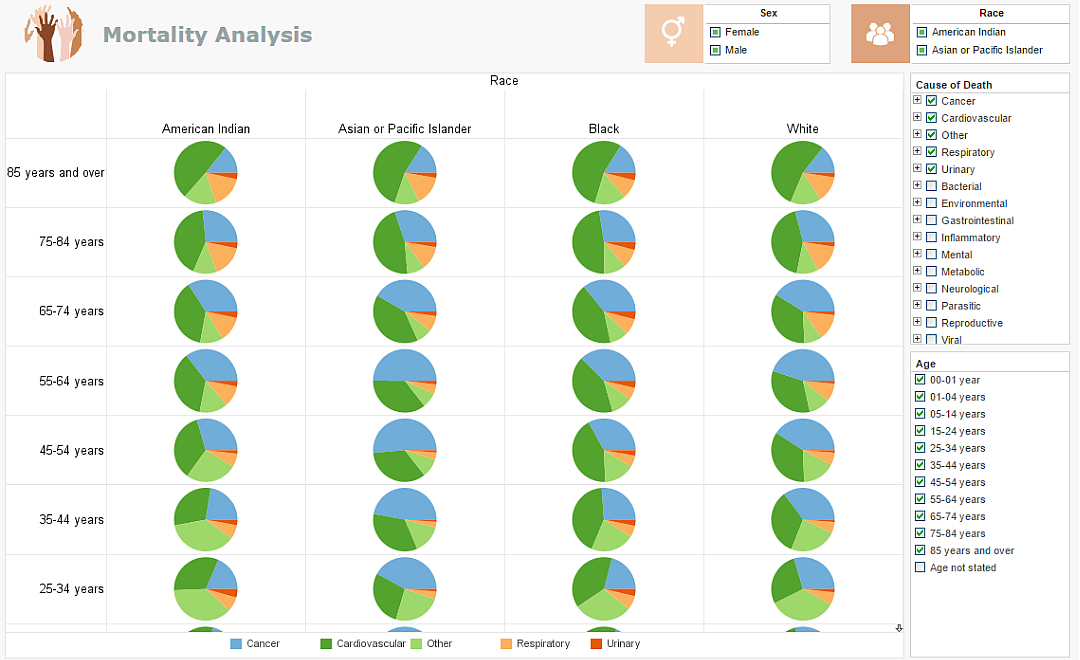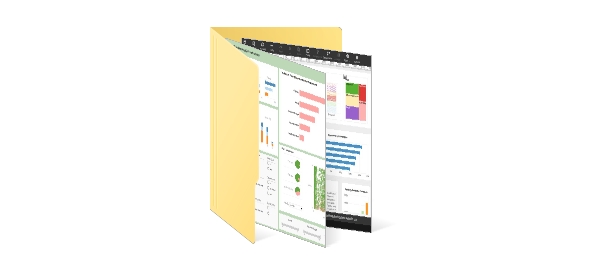Interactive Visual Analysis Example
The interactive visual analysis example portrays the rich and interactive nature of InetSoft's dashboard software. A web-based analytical dashboard, the chart below uses InetSoft's own Data Block patent technology for data mashup purposes, serving as an effective way to analyze multi-dimensional data.
A powerful and effective capability of InetSoft's dashboard solution, demonstrated below, is the simple sorting mechanism that users have control over. Filtering and sorting is easily done with the radio buttons and color coordinated bar chart that includes an array of categories, causes of death, gender, age, and race. Users can take another step and add more charts, data sets, and/or filtering options for further analyzation. InetSoft's solution is geared towards a user-friendly interface that includes an arsenal of useful tools when creating, monitoring, adjusting, or analyzing.
As a pioneer in business intelligence, InetSoft offers only the best tools for dashboard, report, or visual creating while focusing on user-friendliness, user-interactivity, and user objective.
From ChartBlocks to StyleBI: A Hempcrete Producer's Analytics Transformation
In the verdant fields of rural Vermont, GreenHemp Builders has been pioneering sustainable construction materials for over a decade. Specializing in hempcrete—a carbon-negative biocomposite made from hemp hurds, lime, and water—the company represents the forefront of eco-friendly building solutions. Hempcrete's unique properties, including superior insulation, fire resistance, and breathability, have positioned GreenHemp as a leader in the niche market of natural building materials. However, as demand surged with growing awareness of green construction, the company's operations expanded rapidly. Production scaled from artisanal batches to industrial volumes, supply chains stretched across continents for hemp sourcing, and sales diversified into international markets. This growth brought a deluge of data: inventory levels, production yields, quality metrics, sales forecasts, and sustainability reports. To navigate this complexity, GreenHemp initially turned to ChartBlocks, a straightforward visualization tool that promised quick dashboards without coding. But as the hempcrete revolution accelerated, so did the limitations of their setup, prompting a pivotal switch to StyleBI, an advanced business intelligence platform that unlocked deeper insights and operational agility.
The Rise of Hempcrete and Data's Role in Production
Hempcrete production is a delicate alchemy. It begins with industrial hemp stalks, harvested and processed into hurds—the woody inner core—mixed with a lime-based binder and water to form a lightweight, moldable material. Unlike traditional concrete, hempcrete cures through carbon sequestration, absorbing CO2 and contributing to net-zero goals. For GreenHemp, producing high-quality hempcrete means monitoring variables like moisture content (ideally 20-25%), mixing ratios (1:1.5:0.5 for hurds:lime:water), curing times (up to 28 days), and batch density (around 415 kg/m³). Deviations can lead to structural weaknesses or wasted resources, critical in an industry where sustainability isn't just a buzzword—it's a mandate.
Early on, GreenHemp's data needs were modest. A simple spreadsheet tracked daily outputs, and basic charts in ChartBlocks visualized trends like monthly production volumes or raw material costs. The tool's drag-and-drop interface allowed non-technical staff, such as plant managers and agronomists, to build visuals without IT intervention. For instance, a bar chart comparing hemp yield per acre across seasons helped optimize planting schedules. Yet, as the company grew to three production facilities and a workforce of 150, these rudimentary views fell short. Supply chain disruptions—from fluctuating lime prices in Europe to hemp shortages due to weather—demanded real-time correlation analysis. Sales data from eco-build expos and online B2B portals needed integration with production forecasts to avoid overstocking biodegradable molds. ChartBlocks, while user-friendly, struggled with multi-source data blending, custom calculations, and mobile responsiveness, leaving teams siloed and decisions reactive.
Challenges with ChartBlocks: When Simplicity Becomes a Straitjacket
ChartBlocks served as GreenHemp's first foray into visual analytics, offering pre-built widgets for line graphs, pie charts, and gauges that mapped to Google Sheets or SQL databases. The setup was quick: import hemp moisture logs, and voila—a dashboard showing variance from targets. It empowered the quality control team to spot anomalies, like a spike in rejected batches due to over-hydration, reducing waste by 15% in the first year. However, scalability issues emerged swiftly. As data volume tripled with IoT sensors on mixers tracking pH levels in real-time, ChartBlocks choked on refreshes, often lagging by minutes during peak hours.
Customization was another pain point. Hempcrete's unique metrics—such as carbon sequestration per cubic meter (typically 100-150 kg CO2e saved)—required bespoke formulas that ChartBlocks' limited scripting couldn't handle elegantly. Integrating sustainability KPIs, like water usage per ton (aiming for under 200 liters), with financials proved clunky, forcing manual exports to Excel for cross-analysis. Mobile access, vital for field agronomists checking soil tests on tablets, was inconsistent; dashboards rendered poorly on smaller screens, frustrating on-site decisions. Moreover, collaboration features were basic—no shared annotations or version control—leading to email chains of screenshot updates. By mid-2024, as GreenHemp eyed expansion into hempcrete block prefabrication, these constraints risked stalling growth. The C-suite recognized the need for a tool that could evolve with their eco-vision: one that fused production data with market trends, environmental impacts, and predictive modeling.
Discovering StyleBI: A Beacon for Advanced Visualization
The search for a successor led GreenHemp to StyleBI, developed by InetSoft as a robust, agile BI solution tailored for mid-sized enterprises. Unlike ChartBlocks' focus on simplicity, StyleBI emphasizes flexibility, embedding advanced analytics into intuitive designs. Its scorecard architecture allows for hierarchical views—drilling from company-wide sustainability scores to facility-specific yield efficiencies—perfect for hempcrete's layered processes. What captivated GreenHemp's IT director, Elena Vasquez, was StyleBI's seamless data connectivity: native support for ERP systems like SAP, CRM platforms, and even custom APIs from hemp suppliers' traceability software. No more ETL nightmares; data flowed from disparate sources into unified models.
The migration began with a pilot in Q3 2024. Vasquez's team imported six months of ChartBlocks data—over 50,000 rows of production logs—into StyleBI's repository. The platform's wizard-guided import validated schemas automatically, flagging inconsistencies like mismatched units in lime density readings. Within days, they recreated core dashboards: a heat map of curing chamber temperatures across sites, color-coded by risk of defects (red for >30°C variances). But StyleBI shone in enhancements. Interactive filters let users slice data by hemp variety (e.g., Finola vs. Futura 75), revealing that Finola strains yielded 10% higher sequestration rates. Calculated fields computed on-the-fly metrics, such as cost per sequestered ton ($45 vs. industry $60), blending procurement data with environmental outputs.
Implementation: Seamless Transition and Team Empowerment
Full rollout spanned two months, minimizing disruption through phased adoption. First, production teams adopted StyleBI for daily monitoring. A central dashboard aggregated sensor data into live gauges: mixer RPMs, batch humidity, and output rates, with alerts for thresholds (e.g., vibration anomalies signaling equipment wear). This replaced ChartBlocks' static refreshes, cutting response times from 5 minutes to seconds. Training was a breeze—StyleBI's visual query builder echoed ChartBlocks' drag-and-drop ethos but added SQL-like power without code. Agronomists, previously daunted by tech, now built ad-hoc reports on soil nutrient correlations to hemp hurd quality, boosting yields by 8% in the fall harvest.
Sales and sustainability departments followed suit. A multi-tab interface linked order pipelines to inventory forecasts, using StyleBI's forecasting engine to predict demand spikes during green building conferences. One standout feature: embedded maps visualizing supplier carbon footprints, helping procurement prioritize low-emission lime sources from within 500 miles. Collaboration flourished via shared workspaces; annotated charts on rejection trends sparked cross-team workshops, reducing defects from 7% to 3.5%. Mobile optimization ensured field reps accessed deal-closing visuals—projected ROI for hempcrete-insulated homes—on smartphones, sealing partnerships with architects in California and Ontario.
Key Improvements: From Reactive Charts to Predictive Insights
The switch to StyleBI transformed GreenHemp's analytics from descriptive snapshots to prescriptive powerhouses. Where ChartBlocks offered basic trends, StyleBI delivered AI-infused what-ifs: "What if we adjust mixing ratios for 20% denser blocks?" Simulations projected 15% material savings without compromising strength. Visual variety exploded—funnel charts traced waste through production stages, Sankey diagrams flowed costs from farm to factory, and geographic heat maps highlighted regional sales hotspots, revealing untapped potential in Pacific Northwest eco-villages.
Performance metrics tell the story. Dashboard load times plummeted 70%, handling 10x the data volume. User adoption soared to 95%, with self-service reports cutting IT tickets by half. Environmentally, StyleBI's analytics optimized water recycling loops, slashing usage 22% and enhancing GreenHemp's carbon-negative claims—now verified at 120 kg CO2e per m³. Financially, predictive inventory models averted $150,000 in overstock losses, while dynamic pricing dashboards adjusted for hemp volatility, stabilizing margins at 28%.
Overcoming Hurdles: Lessons from the Switch
No migration is flawless. Initial data mapping snags arose—ChartBlocks' flat structures didn't align with StyleBI's relational models—resolved via InetSoft's support portal and a quick schema tweak. Licensing costs, higher than ChartBlocks' freemium tier, justified themselves through ROI within six months. Cultural resistance from veteran mixers, wedded to paper logs, melted away with hands-on demos showing how StyleBI's touch-friendly interfaces mimicked familiar gauges.
Security upgrades were a boon: role-based access ensured sensitive supplier contracts stayed confidential, unlike ChartBlocks' open shares. Scalability for future IoT expansions—drones monitoring hemp fields, blockchain-tracked origins—positioned GreenHemp for Industry 4.0 in sustainable materials.

The Future: Scaling Sustainability with StyleBI
Today, StyleBI pulses at GreenHemp's core, driving a virtuous cycle of data-informed decisions. Upcoming integrations with climate modeling APIs will forecast weather impacts on hemp growth, preempting shortages. Custom apps for client portals will showcase project-specific sequestration dashboards, differentiating GreenHemp in bids. As hempcrete gains traction—projected 25% market growth by 2030—the platform's extensibility ensures adaptability.
For Elena Vasquez, the switch was transformative: "ChartBlocks got us started, but StyleBI lets us dream bigger—turning hemp into homes that heal the planet, one insightful visualization at a time." In an industry where every batch sequesters carbon, GreenHemp's analytics evolution underscores a truth: the right tools don't just analyze data; they cultivate growth. From modest charts to sophisticated BI, this journey exemplifies how visual intelligence can root sustainable success.


